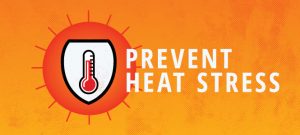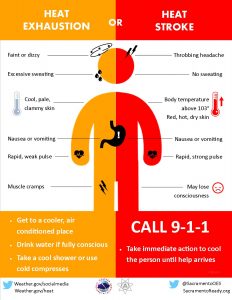
 Heat stress is the leading weather-related killer in the United States, with excessive heat claiming more lives each year than floods, lightning, tornadoes and hurricanes combined. Heat stress can result in heat stroke, heat exhaustion, heat cramps, or heat rashes. Heat can also increase the risk of injuries in workers as it may result in sweaty palms, fogged-up safety glasses, and dizziness.
Heat stress is the leading weather-related killer in the United States, with excessive heat claiming more lives each year than floods, lightning, tornadoes and hurricanes combined. Heat stress can result in heat stroke, heat exhaustion, heat cramps, or heat rashes. Heat can also increase the risk of injuries in workers as it may result in sweaty palms, fogged-up safety glasses, and dizziness.
Heat stress may be exaggerated through the use of personal protective equipment. Consequently, it’s vital that you are aware of the dangers of heat stress and the warning signs.
When employees are required to work in hot environments for extended periods of time, every precaution must be taken to minimize the chances of heat-related illnesses, which may result in death if left untreated. Workers at greater risk of heat stress include those who are 65 years of age or older, are overweight, have heart disease or high blood pressure, or take medications that may be affected by extreme heat.
Here are a few tips to help prevent heat stress:
- Take breaks in cooler, shaded areas and rest regularly.
- Use fans or air conditioning to stay cool.
- Wear protective eyewear that features sufficient ventilation or anti-fog lens coating to reduce lens fogging from the heat.
- Wear light-colored, loose-fitting, breathable clothing such as cotton, recommends OSHA.
- To prevent dehydration, another hazard associated with exposure to heat, drink lots of water, about one cup every 15 minutes.
Signs and symptoms of heat exhaustion may develop suddenly or over time, especially with prolonged periods of exposure. Possible heat exhaustion signs and symptoms include: moist skin with goose bumps when in the heat, heavy sweating, dizziness, fatigue, weak or rapid pulse, muscle cramps and headaches.
In the event that a person falls ill from symptoms of heat stress, call for help and consider calling 911 if person is not alert or seems confused as they may be suffering from heat stroke. Stay with the victim until help arrives and move them to a cooler/shaded area. Fan and mist the victim with water; provide them with cool drinking water, if able to drink
Source: OSHA

